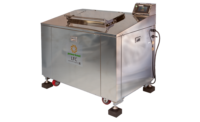The Earth’s climate is changing in response to the increasing amount of greenhouse gasses (GHG) in the atmosphere, with roughly one-third of all GHG emissions being associated with various stages of materials management. This includes extracting raw materials, making them into products and dealing with manufacturing waste and end-of-life disposal.
By following the waste management hierarchy—waste reduction and reuse, recycling and energy recovery—and recognizing waste as a resource, food manufacturers and retailers can reduce the amount of products made from new materials, lessen dependence on fossil fuel-fired electricity and keep material out of landfills.
Whether you’ve set a goal of zero waste, zero landfill or sustainable materials management, the end results are the same—lower environmental impacts from how we manage waste and materials.
A good first step is to perform an audit or opportunity assessment on your company’s waste streams. This exercise can help identify waste reduction, reuse and recycling opportunities across an organization. Once you have identified these opportunities, make a plan and form a team that will drive the steps and changes necessary to reach these goals.
For food manufacturers and retailers specifically, there are many options and outlets for end-of-life waste materials other than disposal at landfills. Food waste can be reused as animal feed, composted or used as a feedstock for anaerobic digesters, which uses microorganisms to break down biodegradable material in the absence of oxygen to create biogas. The gas can be used to fuel a generator to create renewable electricity and heat, or upgraded to natural gas for use in vehicles.
For products with packaging, sustainably managing this material can be more difficult, but more solutions are becoming available for manufacturers and retailers to improve their environmental footprint and demonstrate a commitment to safe and sustainable materials handling.
Innovative depackaging technology removes the liquid contents of “not to be sold” packaged consumer products, which may be expired, recalled or otherwise unusable, from its plastic packaging and recycles it. The depackaging process can be used to recover and recycle a range of goods, from milk and yogurt to household items. The process typically recovers three reusable byproducts from waste that would otherwise be discarded:
- Liquid waste, which is in turn treated and converted into clean, reusable water;
- Remaining food, which can then be sent for composting or energy recovery;
- Residual product packaging, which is then sorted, cleaned and sent to be recycled into new products.
For other unsaleable products that cannot be depackaged, it’s important to find a sustainable yet secure disposal outlet that will protect your brand and mitigate any potential risks. In addition, retailers and manufacturers often have very little storage space for such waste, so quick and efficient disposal is of the utmost importance. Assured destruction at a waste-to-energy facility may be your best option.
Waste-to-energy facilities offer a safe and secure disposal process that destroys materials at temperatures approaching 2,000°F, while generating clean energy and avoiding GHG from landfills. Typically, the entire process can include certificates of destruction to prove materials were thermally destroyed.
Additionally, waste-to-energy is a critical part of a company’s sustainability efforts, effectively capturing the energy value from materials that cannot be recycled. The process provides businesses the ability to reach their zero waste-to-landfill goals and the confidence to promote the achievement as part of sustainability efforts.
By utilizing a range of solutions and technologies to divert waste from landfills, businesses are not only reducing environmental impacts, but also saving costs and minimizing liability. It also can help your organization with GHG reduction, energy efficiency and other environmental goals, satisfy your supply chain requirements and establish your operation as a sustainability leader.


